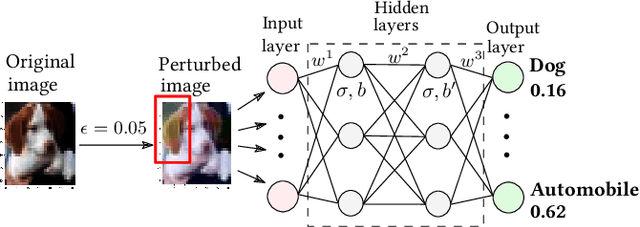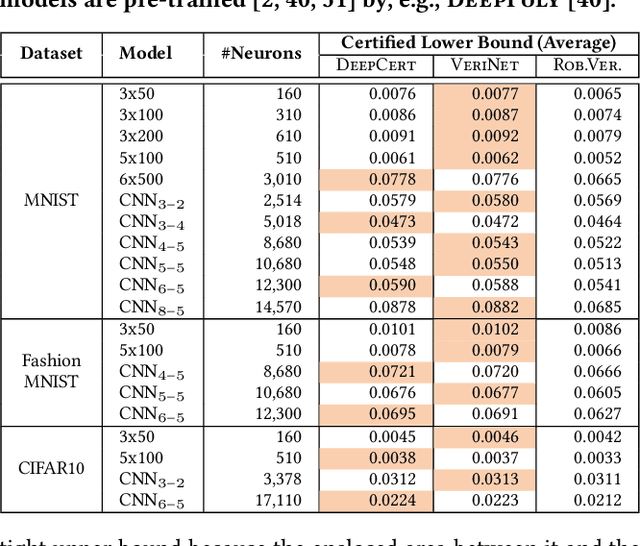Zhaodi Zhang
A Tale of Two Approximations: Tightening Over-Approximation for DNN Robustness Verification via Under-Approximation
May 26, 2023Abstract:The robustness of deep neural networks (DNNs) is crucial to the hosting system's reliability and security. Formal verification has been demonstrated to be effective in providing provable robustness guarantees. To improve its scalability, over-approximating the non-linear activation functions in DNNs by linear constraints has been widely adopted, which transforms the verification problem into an efficiently solvable linear programming problem. Many efforts have been dedicated to defining the so-called tightest approximations to reduce overestimation imposed by over-approximation. In this paper, we study existing approaches and identify a dominant factor in defining tight approximation, namely the approximation domain of the activation function. We find out that tight approximations defined on approximation domains may not be as tight as the ones on their actual domains, yet existing approaches all rely only on approximation domains. Based on this observation, we propose a novel dual-approximation approach to tighten over-approximations, leveraging an activation function's underestimated domain to define tight approximation bounds. We implement our approach with two complementary algorithms based respectively on Monte Carlo simulation and gradient descent into a tool called DualApp. We assess it on a comprehensive benchmark of DNNs with different architectures. Our experimental results show that DualApp significantly outperforms the state-of-the-art approaches with 100% - 1000% improvement on the verified robustness ratio and 10.64% on average (up to 66.53%) on the certified lower bound.
Boosting Verified Training for Robust Image Classifications via Abstraction
Mar 21, 2023Abstract:This paper proposes a novel, abstraction-based, certified training method for robust image classifiers. Via abstraction, all perturbed images are mapped into intervals before feeding into neural networks for training. By training on intervals, all the perturbed images that are mapped to the same interval are classified as the same label, rendering the variance of training sets to be small and the loss landscape of the models to be smooth. Consequently, our approach significantly improves the robustness of trained models. For the abstraction, our training method also enables a sound and complete black-box verification approach, which is orthogonal and scalable to arbitrary types of neural networks regardless of their sizes and architectures. We evaluate our method on a wide range of benchmarks in different scales. The experimental results show that our method outperforms state of the art by (i) reducing the verified errors of trained models up to 95.64%; (ii) totally achieving up to 602.50x speedup; and (iii) scaling up to larger models with up to 138 million trainable parameters. The demo is available at https://github.com/zhangzhaodi233/ABSCERT.git.
DualApp: Tight Over-Approximation for Neural Network Robustness Verification via Under-Approximation
Nov 21, 2022Abstract:The robustness of neural networks is fundamental to the hosting system's reliability and security. Formal verification has been proven to be effective in providing provable robustness guarantees. To improve the verification scalability, over-approximating the non-linear activation functions in neural networks by linear constraints is widely adopted, which transforms the verification problem into an efficiently solvable linear programming problem. As over-approximations inevitably introduce overestimation, many efforts have been dedicated to defining the tightest possible approximations. Recent studies have however showed that the existing so-called tightest approximations are superior to each other. In this paper we identify and report an crucial factor in defining tight approximations, namely the approximation domains of activation functions. We observe that existing approaches only rely on overestimated domains, while the corresponding tight approximation may not necessarily be tight on its actual domain. We propose a novel under-approximation-guided approach, called dual-approximation, to define tight over-approximations and two complementary under-approximation algorithms based on sampling and gradient descent. The overestimated domain guarantees the soundness while the underestimated one guides the tightness. We implement our approach into a tool called DualApp and extensively evaluate it on a comprehensive benchmark of 84 collected and trained neural networks with different architectures. The experimental results show that DualApp outperforms the state-of-the-art approximation-based approaches, with up to 71.22% improvement to the verification result.
Provably Tightest Linear Approximation for Robustness Verification of Sigmoid-like Neural Networks
Aug 21, 2022



Abstract:The robustness of deep neural networks is crucial to modern AI-enabled systems and should be formally verified. Sigmoid-like neural networks have been adopted in a wide range of applications. Due to their non-linearity, Sigmoid-like activation functions are usually over-approximated for efficient verification, which inevitably introduces imprecision. Considerable efforts have been devoted to finding the so-called tighter approximations to obtain more precise verification results. However, existing tightness definitions are heuristic and lack theoretical foundations. We conduct a thorough empirical analysis of existing neuron-wise characterizations of tightness and reveal that they are superior only on specific neural networks. We then introduce the notion of network-wise tightness as a unified tightness definition and show that computing network-wise tightness is a complex non-convex optimization problem. We bypass the complexity from different perspectives via two efficient, provably tightest approximations. The results demonstrate the promising performance achievement of our approaches over state of the art: (i) achieving up to 251.28% improvement to certified lower robustness bounds; and (ii) exhibiting notably more precise verification results on convolutional networks.
Accelerating Robustness Verification of Deep Neural Networks Guided by Target Labels
Jul 27, 2020



Abstract:Deep Neural Networks (DNNs) have become key components of many safety-critical applications such as autonomous driving and medical diagnosis. However, DNNs have been shown suffering from poor robustness because of their susceptibility to adversarial examples such that small perturbations to an input result in misprediction. Addressing to this concern, various approaches have been proposed to formally verify the robustness of DNNs. Most of these approaches reduce the verification problem to optimization problems of searching an adversarial example for a given input so that it is not correctly classified to the original label. However, they are limited in accuracy and scalability. In this paper, we propose a novel approach that can accelerate the robustness verification techniques by guiding the verification with target labels. The key insight of our approach is that the robustness verification problem of DNNs can be solved by verifying sub-problems of DNNs, one per target label. Fixing the target label during verification can drastically reduce the search space and thus improve the efficiency. We also propose an approach by leveraging symbolic interval propagation and linear relaxation techniques to sort the target labels in terms of chances that adversarial examples exist. This often allows us to quickly falsify the robustness of DNNs and the verification for remaining target labels could be avoided. Our approach is orthogonal to, and can be integrated with, many existing verification techniques. For evaluation purposes, we integrate it with three recent promising DNN verification tools, i.e., MipVerify, DeepZ, and Neurify. Experimental results show that our approach can significantly improve these tools by 36X speedup when the perturbation distance is set in a reasonable range.
 Add to Chrome
Add to Chrome Add to Firefox
Add to Firefox Add to Edge
Add to Edge